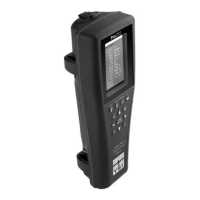33
Calibration
3.3
Conductivity
The conductivity/temperature sensor can measure and calculate conductivity, specific conductance (temperature
compensated conductivity), salinity, non-linear function (nLF) conductivity, TDS, resistivity, and density. Calibration
is only available for specific conductance, conductivity, and salinity. Calibrating one of these options automatically
calibrates the other conductivity/temperature parameters listed above. For both ease of use and accuracy, YSI
recommends calibrating specific conductance.
Select the appropriate calibration standard for the conductivity of the sampling environment. Standards at least 1 mS/
cm (1000 μs/cm) are recommended for the greatest stability. For fresh water applications, calibrate to 1,000. For salt
water applications, calibrate to 50,000 μS.
Conductivity Calibration
1. Make sure the conductivity sensor is clean prior to calibration. If
necessary, clean the conductivity cell with the supplied soft brush.
2. Place the correct amount of conductivity standard into a clean and
dry or pre-rinsed calibration cup.
3. Carefully immerse the sensors into the solution. Make sure the
solution is above the vent holes on the side of the conductivity
sensor.
If using the ODO/CT assembly, ensure the vent holes at the top
of the sensor are completely immersed and the solution level is at
least 1 cm higher than the top vent holes (Figure 49). A graduated
cylinder is included with ODO/CT cable assemblies for the
purpose of calibrating conductivity.
For 4-port cable assemblies, fill the calibration cup to the second
line with fresh calibration standard. It takes 225 mL of solution to
fill to line 2.
4. Gently rotate and/or move the sensor up and down to remove any
bubbles from the conductivity cell. Allow at least 40 seconds for
temperature equilibration before proceeding.
5. Push the
Cal
key, select Conductivity, then select Specific
Conductance.
6. Select Calibration value then enter the calibration value of the
standard used. Note the measurement units the instrument is
reporting and calibrating and be sure to enter in the correct
calibration value for the units being used. For example, 10,000 μS
= 10 mS. Make sure that the units are correct and match the units
displayed on the handheld.
7. Observe the actual measurement readings for stability (white line
on graph shows no significant change for 40 seconds), then select
Accept Calibration (Figure 48). “Calibration successful!” will be
displayed in the message area.
Figure 48 Calibrate specific
conductance
Figure 49 ODO/CT Cable Assembly
Top Vent Holes
Side Vent
Holes
(continued on next page)

